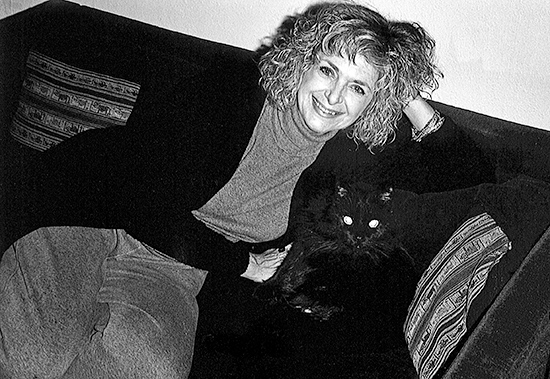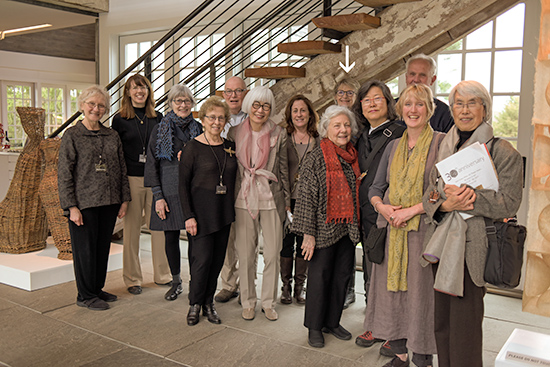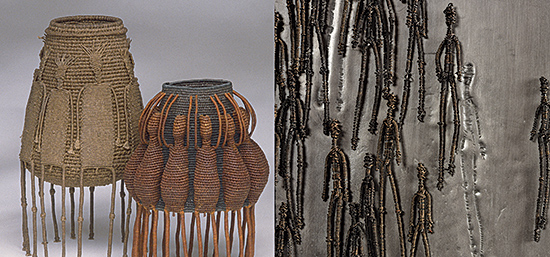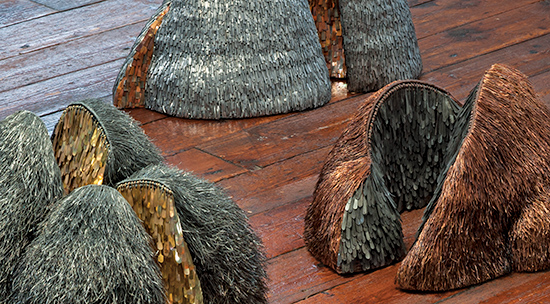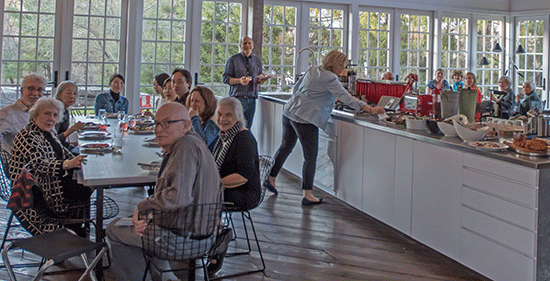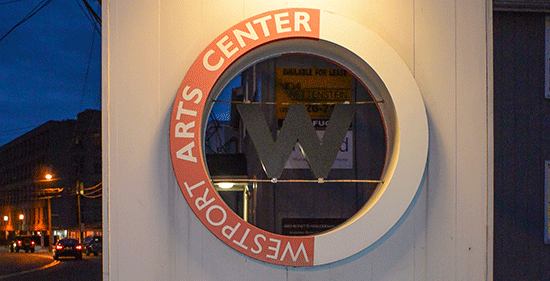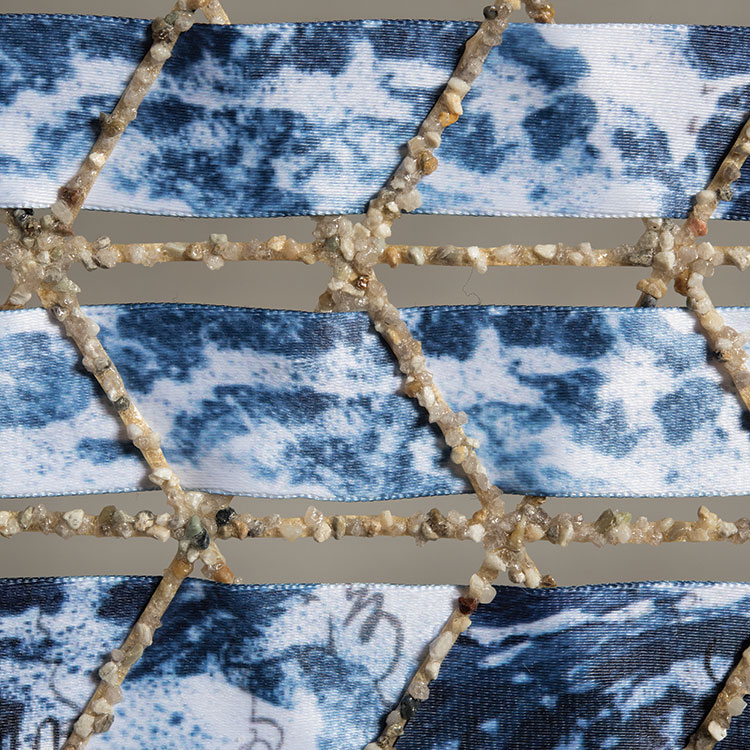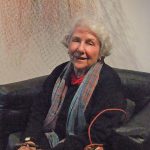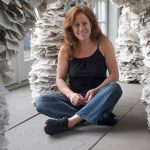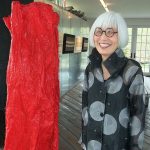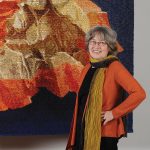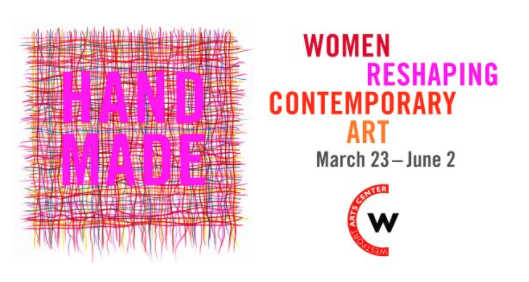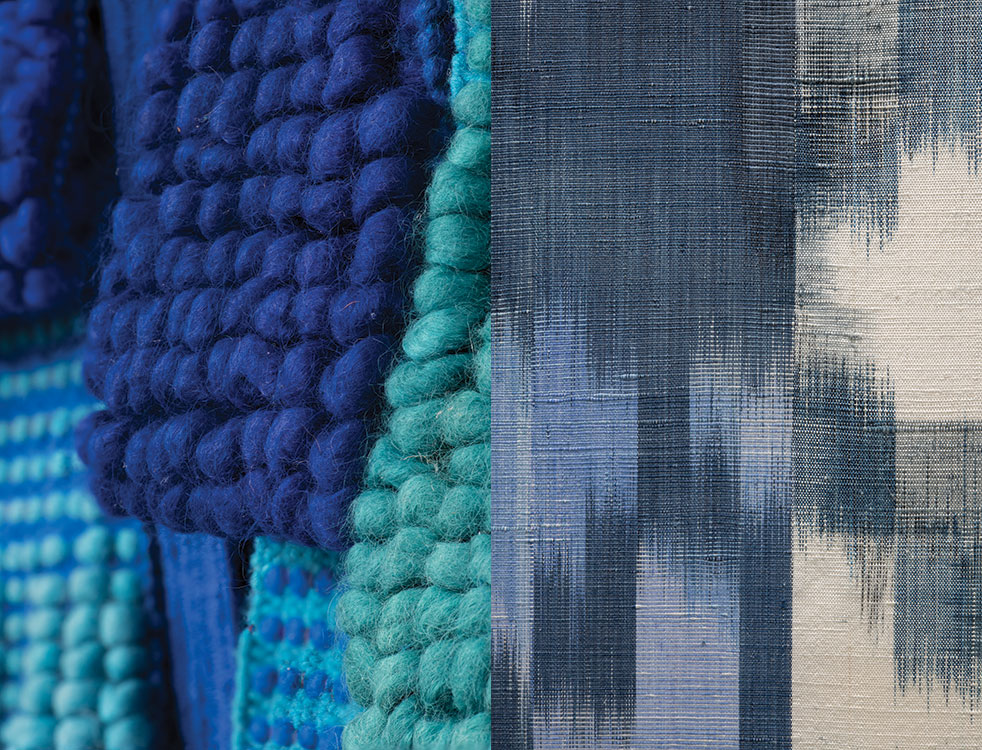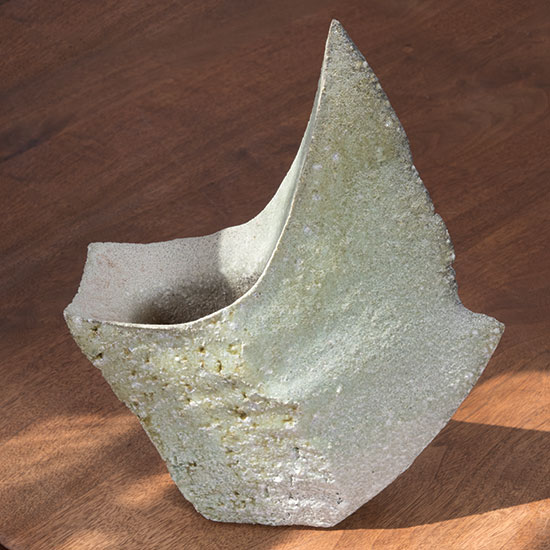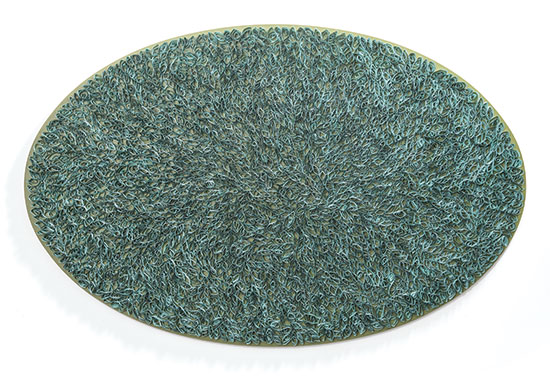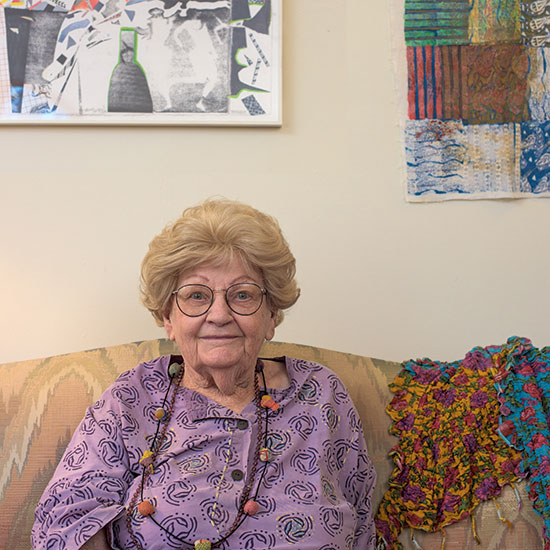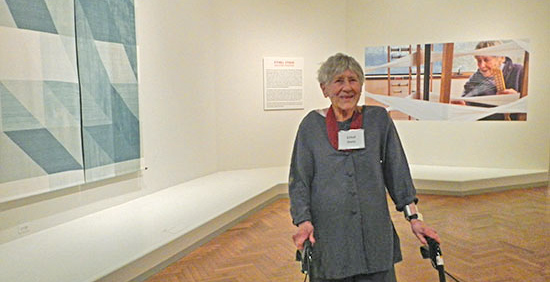We were heartbroken to learn of artist Mary Giles’s passing last month. Giles was a light – casting warmth and humor wherever she went. We have been fortunate to represent her work at browngrotta arts for many years and were delighted she could join us in Wilton for our 30th anniversary exhibition last year.
Art Lives Well-Lived: Mary Giles
Recap: Whirlwind Art Week in Wilton at browngrotta arts
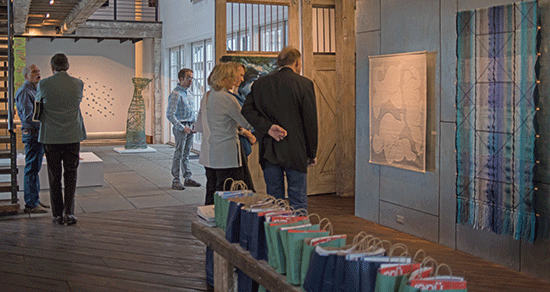
VIP-opening, photo by Carter Grotta
We had record crowds in attendance and a record number of sales at browngrotta arts in Wilton last week for Blue/Green: color/code/context. At our VIP preview event on Friday, we hosted our clients, collectors and art appreciators and our event sponsors from Litchfield Distillery, venü Magazine and Country Club Homes.
Saturday we hosted 10 artists from the exhibition (Keiji Nio and family all the way from Japan, Kiyomi Iwata from Virginia, Pat Campbell from Maine, Lewis Knauss, Nancy Koenigsberg, Polly Barton and Tamiko Kawata from New York, Wendy Wahl from Rhode Island and Dawn MacNutt from Nova Scotia) and loads of visitors, too. Sunday and Monday we were busy all day.
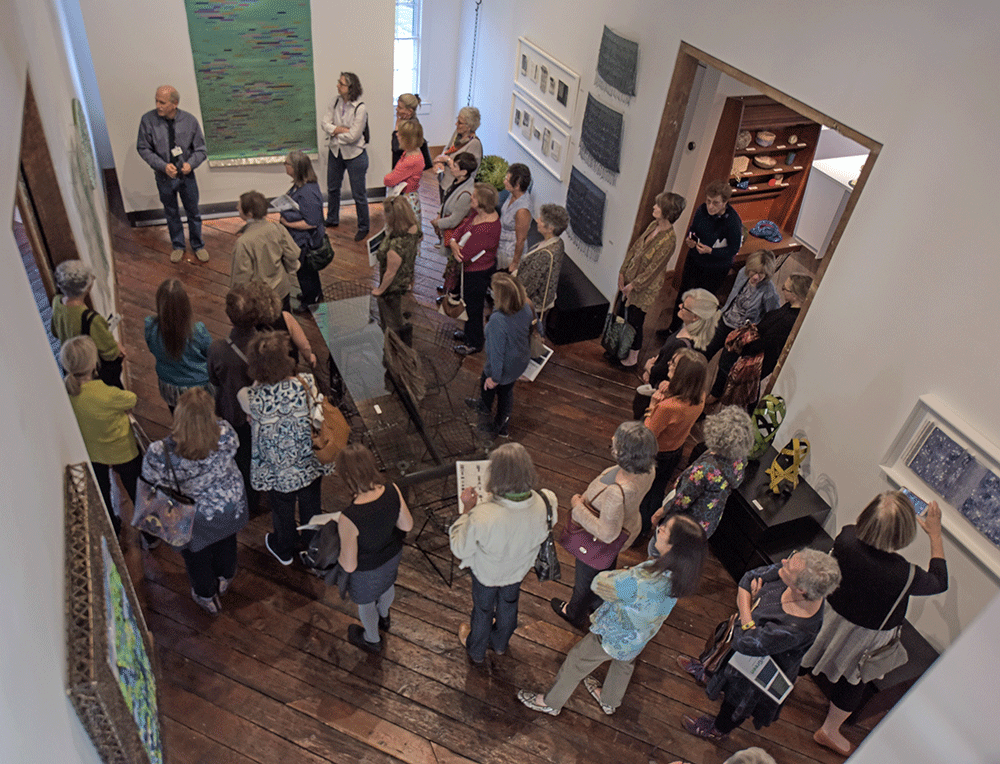
Surface Design Association Talk. Photo by Carter Grotta
Tuesday we hosted a good crowd of appreciative and knowledgable members of the Surface Design Association.
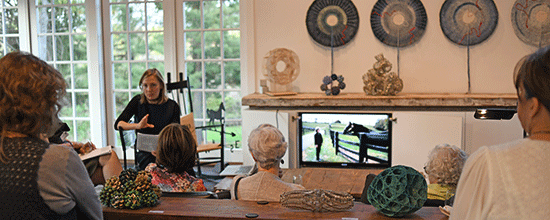
Mae Colburn presentation of Helena Hernmarck work at the Architecture and Designer Talk. Photo by Carter Grotta
Wednesday was educational — we presented Material Matter: Integrating Art Textiles and Fiber Sculpture into Interiors and Architecture with the help of Mae Colburn from Helena Hernmarck’s studio and some interior shots from Walter Cromwell at Country Club Homes. Those in attendance were eligible to get Continuing Education Credit from the Interior Design Continuning Education Council.
Thursday brought the Westport Arts Council Board and patrons another educated and interested audience.
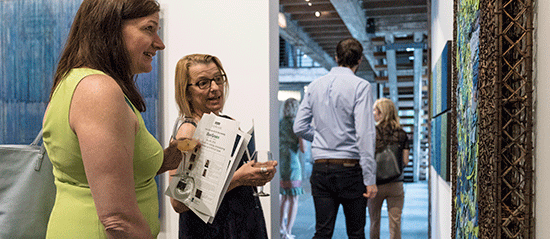
Ports of cause fundraiser. photo by Harrison James O’Brien
Friday was Art•Ocean•Energy, an immersive art experience for supporters of Ports of Cause, a 501(c)3 driven to promote, inspire and accelerate innovative and sustainable solutions and practices that reduce the impact luxury living and everyday lifestyles have on our oceans. Those who joined us on Friday, heard Tom speak about our artists’ dedication to sustainable art and art practices and
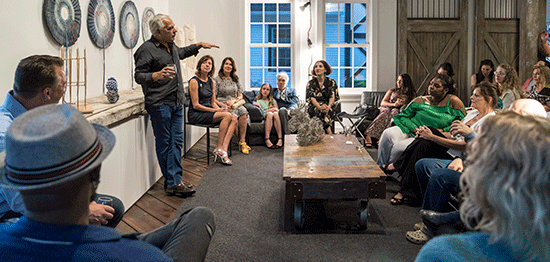
Arthur Bavelas talking at Ports of Cause fundraiser. photo by Harrison James O’Brien
Arthur Bavelas, Founder of the Bavelas Group Family Office & Family Office Insights of New York City, speak about How sustainable innovation is driving the blue economy while benefiting our oceans and natural resources. A lively discussion followed. Saturday was a full day as was Sunday. Sunday evening we concluded our 10-day annual opening with a informed and engaged group from the Aldrich Museum in Ridgefield, Connecticut. Hope we’ll see you at browngrotta arts in 2019 at one or more of our annual events. In the meantime, you can find us online at browngrotta.com; talking about events and acquisitions and other art stuff at arttextstyle.com and on Facebook, posting items and images on Twitter and Instagram and videos on the browngrotta arts YouTube Channel.
Countdown: Art-Ocean-Energy Fundraiser for Ports of Cause in Two Days at browngrotta arts
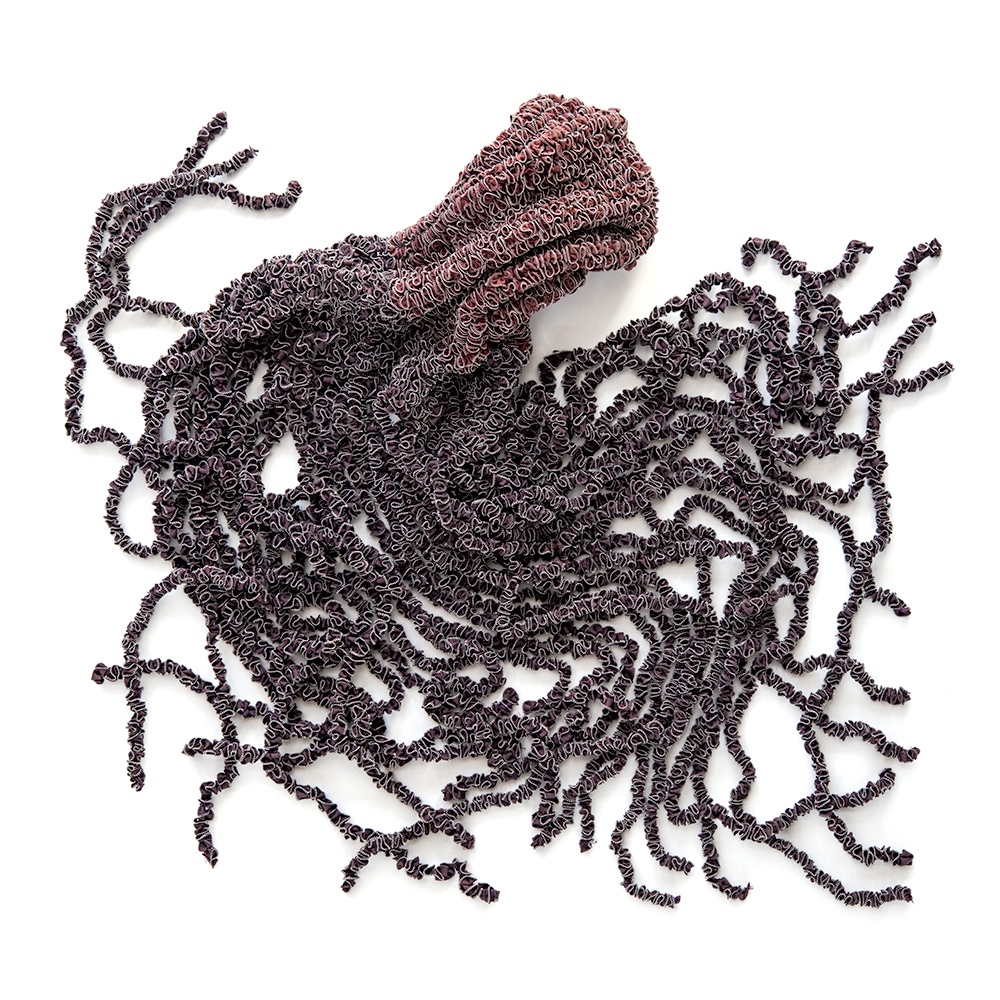
Karyl Sisson, Reaching Out, vintage zipper tape and thread, 8 x 56 x 45 in,
2013. Photo by Tom Grotta
Artists in the House: Who’s attending the Opening of Blue/Green: color/code/context on Saturday
The Artists Reception and Opening for Blue/Green: color/code/context occurs this Saturday at browngrotta arts, 276 Ridgefield Road, Wilton, Connecticut 06897. Eleven of the participating artists will be in attendance, enhancing what is always an energizing opportunity to experience our annual Art in the Barn event. Keiji Nio and his family are coming from Japan, Pat Campbell from Maine, Wendy Wahl from Rhode Island, Kiyomi Iwata from Virginia, Norma Minkowitz and Helena Hernmarck from Connecticut and Polly Barton, John McQueen, Nancy Koenigsberg, Lewis Knauss and Tamiko Kawata from New York. Wendy Wahl’s work is made of blue Encyclopedia Britannica pages; John McQueen used plastic bottles — a departure for him. Norma Minkowitz has created a detailed and magical stitched drawing and Lewis Knauss a work of pale, pale green and natural reed and twigs. Join us from 1-5 pm to see their work and that of 50 more artists. The artists will be available throughout the Barn, to answer questions about their work, their favorites or about the work of others. They’ll be wearing name tags — feel free to say hello. For more info: http://www.browngrotta.com/Pages/calendar.php; 203-834-0623. Or visit us during the week — Sunday April 29th – Sunday May 6th, 10-5 pm.
Make a Day of It: Area Events to Visit on Your Way to Blue/Green at browngrotta arts
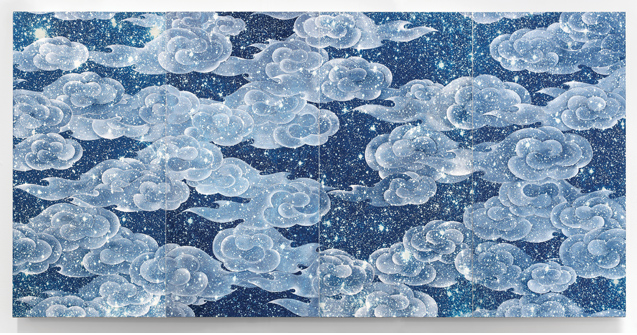
Ala Ebtekar’s Zenith V at Long, Winding Journeys: Contemporary Art and the Islamic Tradition. Photo: Katonah Museum of Art
Who is new in Blue/Green: code/color/context — Micheline Beauchemin and Polly Barton
First Look: Blue/Green: color/code/context, April 28th – May 6th at bga, Wilton, CT
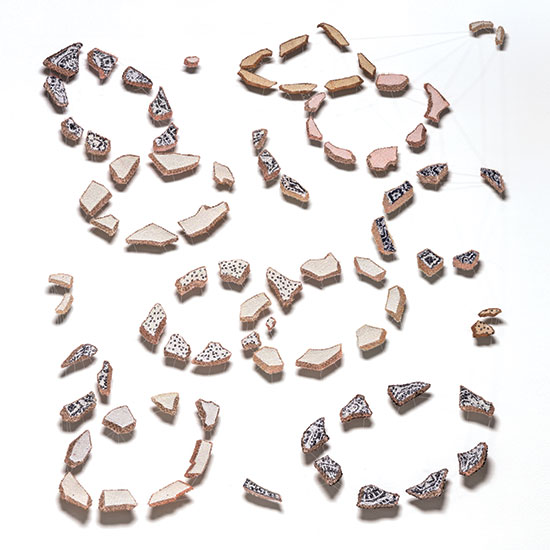
30mb Dutch Blue (Oval), Marian Bijlenga
camelhair, fabric, stitched
35” x 35”, 2006, photo by Tom Grotta
For this year’s Art in the Barn exhibition, we asked artists to enter a blue or green period of their own and send us a work that conveyed one of the many meanings, connotations and moods of these colors. The result is Blue/Green: color/code/context, an exhibition of remarkably diverse works from more than 50 artists from 15 countries. Marian Bijlenga of the Netherlands, for example, has created an enigmatic wall work inspired by Dutch blue china fragments. The work is inspired, she says, by the patterns of Chinese porcelain and the Japanese philosophy of the reuse of broken tiles and her collection of Dutch blue shards, collected in Amsterdam.
Yasuhisa Kohyama has created, Kaze, a ceramic with a grey-greenish cast, hand built and wood fired in an anagama kiln. “With the properties of the shigaraki clay and its inclusions of feldspar and silica, the high heat, the atmosphere in the kiln and the falling of the wood ash on the pots all present, warm colors as well as attractive markings can be captured on the surface of the clay,” Kohyama explains. “The blue-green and red-orange colors develop in the mid-section of the kiln; In the back of the kiln, a heavily reduced atmosphere creates rich dark gray and brown colors.”
The Green Horizon is the striking abstract tapestry created by Gudrun Pager of Denmark for the exhibition. “Perhaps it is the horizon between heaven and sea, or between heaven and earth – or the line between heaven and earth?” Pagter muses. “The thin, horizontal line is made with many shades of blue and green thin linen. The main color is blue, but the thin, green horizon is essential to the whole picture.”
Encylopedia Britanica pages are the material Wendy Wahl uses to express our station in time, recognizable as they are as a part of a particular collective consciousness. Wahl’s Changing Tides is made of 275 pages of the 1988 Encyclopedia Britannica Annual of World Data, the only book in Wahl’s collection of EB volumes that contained blue paper. The pages were cut into seven sections, for each of the continents, contemplatively scrolled and compressed into 1925 whorls to symbolize the reality of rising water around the globe. These four are just a sampling of the more than 70 works that will be on display in the Blue/Green: color/code/context exhibition and in the companion catalog, which will be available at www.browngrotta.com after April 28th. To visit Blue/Green: color/code/context, here are the details: Saturday, April 28th, 1-6 pm: Opening and Artists Reception
HandMade: Women Reshaping Contemporary Art

Norma Minkowitz’s Excavation in the foreground, Carolina Yrarrázaval’s tapestries in the background.
Last Friday, the Westport Arts Center opened up its new exhibition, Handmade: Women Reshaping Contemporary Art, which includes three artists, Chiyoko Tanaka, Carolina Yrarrázaval and Norma Minkowitz, represented by browngrotta arts. The exhibition was curated by Elizabeth Gorayeb, the Executive Director of the Wildenstein Plattner Institute, Inc., a New York based non-profit committed to art historical research. Handmade also features work by Ghada Amer, Anna Betbeze, Ligia Bouton, Orly Cogan, Lesley Dill, Terri Friedman, Sermin Kardestuncer, Sophia Narrett, Faith Ringgold, Miriam Schapiro, Judith Scott, Beverly Semmes, Rosemarie Trockel and Margo Wolowiec, all of whom utilize fiber and textile in their art.

301 balls (Diptych), 2017
Cotton thread, coal from Soma, Turkey, fabric
36 × 37 in, 2017. Photo by Tom Grotta
“As visitors to a gallery or museum, we are expected to engage with works of art though the act of looking. We consider the final product of the artist’s creation, but rarely do we think of the tactile experience of the artist’s process,” explains Gorayeb. “Fiber art — works of art created from wool, silk, cotton, flax and other forms of textiles — present us with a dynamic, multi-sensory experience.” It is because of this tactile experience and physical commitment that Narrett prefers embroidery over painting, “when an object is developed by human hands for hundreds of hours, it leaves a quality in the surface that can be sensed,” she notes.
Art Lives Well Lived: Katherine Westphal and Ethel Stein
We lost two fine artists and friends this month when Ethel Stein passed away at 100 and Katherine Westphal died at home in Berkeley, California at 99.
Six years later, Ethel’s work received the wider recognition it deserved. We were thrilled to attend the opening of her one-person exhibition, Ethel Stein, Master Weaver, at the Art Institute of Chicago in 2014. “Ethel Stein is an artist who only now, at the age of 96, is beginning to get the recognition she deserves from the broader public,” the Institute wrote. “Stein’s great contribution to weaving is her unique combination of refined traditional weaving techniques, possible only on a drawloom and used by few contemporary weavers, with modernist sensibilities influenced by Josef Albers, who trained in the German Bauhaus with its emphasis on simplicity, order, functionality, and modesty.” There were photos of her at work, a video and a dinner after with family members and supporters of the museum and crowds of visitors to the exhibition — a well-deserved tribute.
These artists and their lengthy careers, raise the question, is fiber art a key to longevity? Ethel Stein continued to weave even after she was discovered and lauded at 96. When we visited Katherine Westphal in Berkeley in 2015 we found her still drawing or painting every day in a series of journals she kept, something she continued to do until just a few weeks before her death. Lenore Tawney died at 100, Ruth Asawa and Magdalena Abakanowicz each at 87. Helena Hernmarck tells us that she knows several fiber artists who are 100. So those of you who are practitioners — keep it up!
Art Out and About: Patrick Dougherty at the Ackland Art Museum
 Raised in North Carolina and an alumnus of the University of North Carolina at Chapel Hill, sculptor Patrick Dougherty returned to his roots to create Step Right Up for the Ackland Art Museum last October. Internationally acclaimed for his monumental environmental works, Dougherty has produced over 280 large scale stick sculptures all over the world. You’ll know one of Dougherty’s sculptures when you see one. “Some cling to pylons or walls, or roll across the tops of trees; others emerge from a lake, seeming to balance on the surface of it without making a single ripple,” explains Daniel Wallace of Garden & Gun. “His sculptures do impossible things. They could be homes for giants or trolls, the first shelters built by prehistoric men, Gaudí-esque mazes, giant vines, remnants of alien visitations, windblown towers, jokes. They are fun, joyous, friendly, inviting, and public, very public: art conceived by one, built by many, shared by all.”
Raised in North Carolina and an alumnus of the University of North Carolina at Chapel Hill, sculptor Patrick Dougherty returned to his roots to create Step Right Up for the Ackland Art Museum last October. Internationally acclaimed for his monumental environmental works, Dougherty has produced over 280 large scale stick sculptures all over the world. You’ll know one of Dougherty’s sculptures when you see one. “Some cling to pylons or walls, or roll across the tops of trees; others emerge from a lake, seeming to balance on the surface of it without making a single ripple,” explains Daniel Wallace of Garden & Gun. “His sculptures do impossible things. They could be homes for giants or trolls, the first shelters built by prehistoric men, Gaudí-esque mazes, giant vines, remnants of alien visitations, windblown towers, jokes. They are fun, joyous, friendly, inviting, and public, very public: art conceived by one, built by many, shared by all.”
What separates Step Right Up from Dougherty’s other installations is that it is in his hometown of Chapel Hill, North Carolina. Dougherty earned his B.A. in English from the UNC in 1967 and later returned to study art history and sculpture. Before he began using sticks as his medium, Dougherty sculpted with clay. However, while using clay Dougherty was unable to achieve the scale he desired for his sculptures. While studying at UNC, Dougherty developed the idea of using sticks as his medium. Dougherty found that using sticks allowed him to bend and extend long lines, he could create his own monumental three-dimensional drawings. In order to effectively use sticks to create sculptures, Dougherty had to gain a better understanding of how shelter builders, such as birds and beavers, build their homes. “Sticks have an inherent method of joining…and that tangling allows you to hook them together,” Dougherty explains.
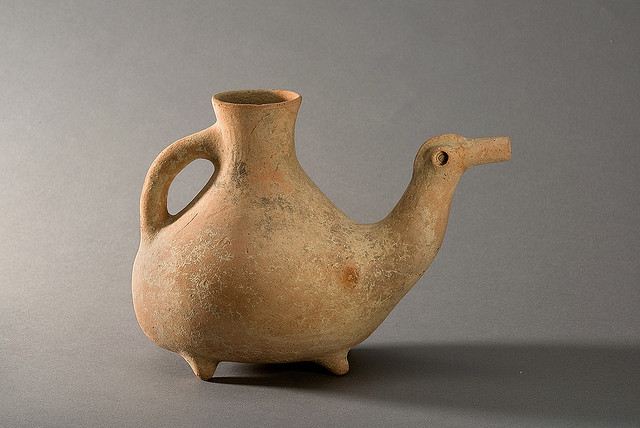
Unknown, Iranian, Caspian Region, ca. early 1st millennium B.C., Animal-shaped Pouring Vessel, earthenware, Overall: 8 3/4 x 12 x 6 3/16 in. (22.3 x 30.5 x 15.7 cm) Ackland Art Museum, University of North Carolina at Chapel Hill, Gift of Osborne and Gratia B. Hauge in honor of Dr. and Mrs. Sherman E. Lee, 91.21 © Ackland Art Museum, University of North Carolina at Chapel Hill
Dougherty often does not know what he is going to build until after he arrives at the installation site. Once he arrives, Dougherty has to source both volunteers and materials. For his exhibition Step Right Up at the Ackland Art Museum Dougherty was able to source his materials—maple and gum saplings—from Duke Forest and Triangle Land Conservancy, organizations Dougherty has had long relationships with throughout his career. Dougherty chooses to enlist the help of volunteers on his projects because he finds it interesting how varying types of characters can come together to create one piece. Dougherty’s creative process has three steps: 1) Structural formation—building the basic shape, 2) Appliqué—appliquéing a look onto the surface of the piece and 3) Cosmetic—fixing up and making it habitable for people to enjoy from both the inside and outside. In creating Step Right Up for the Ackland, Dougherty was inspired by the Ackland’s collection of ancient animal pouring vessels. The vessels, which usually have an animal head from which water is poured, typically have traditional tops. Dougherty liked the idea of having a mixed shape and applied it to his sculpture in Step Right Up.
“I think that part of my work’s allure is its impermanence, the life cycle that is built into the growth and decay of saplings,” explains Dougherty. “The line between trash and treasure is thin, and the sculptures, like the sticks they are made from, begin to fade after two years. Often the public imagines that a work of art should be made to last, but I believe that a sculpture, like a good flower bed, has its season.” Bounded to the installations organic material and outdoor setting, Dougherty’s Step Right Up is a temporary installation. The installation is expected to be on view through August 31, 2018 at the Ackland Art Museum in Chapel Hill, North Carolina. For more information, visit: https://ackland.org/exhibition/patrick-dougherty-stickwork-ackland/.
Search
Subscribe2
Recent Posts
- January 7, 2026
- January 1, 2026
- December 25, 2025
Pages
blogroll
Archives
- January 2026
- December 2025
- November 2025
- October 2025
- September 2025
- August 2025
- July 2025
- June 2025
- May 2025
- April 2025
- March 2025
- February 2025
- January 2025
- December 2024
- November 2024
- October 2024
- September 2024
- August 2024
- July 2024
- June 2024
- May 2024
- April 2024
- March 2024
- February 2024
- January 2024
- December 2023
- November 2023
- October 2023
- September 2023
- August 2023
- July 2023
- June 2023
- May 2023
- April 2023
- March 2023
- February 2023
- January 2023
- December 2022
- November 2022
- October 2022
- September 2022
- August 2022
- July 2022
- June 2022
- May 2022
- April 2022
- March 2022
- February 2022
- January 2022
- December 2021
- November 2021
- October 2021
- September 2021
- August 2021
- July 2021
- June 2021
- May 2021
- April 2021
- March 2021
- February 2021
- January 2021
- December 2020
- November 2020
- October 2020
- September 2020
- August 2020
- July 2020
- June 2020
- May 2020
- April 2020
- March 2020
- February 2020
- January 2020
- December 2019
- November 2019
- October 2019
- September 2019
- August 2019
- July 2019
- June 2019
- May 2019
- April 2019
- March 2019
- February 2019
- January 2019
- December 2018
- November 2018
- October 2018
- September 2018
- August 2018
- July 2018
- June 2018
- May 2018
- April 2018
- March 2018
- February 2018
- January 2018
- December 2017
- November 2017
- October 2017
- September 2017
- August 2017
- July 2017
- June 2017
- May 2017
- April 2017
- March 2017
- February 2017
- January 2017
- December 2016
- November 2016
- October 2016
- September 2016
- August 2016
- June 2016
- April 2016
- March 2016
- February 2016
- December 2015
- October 2015
- September 2015
- August 2015
- June 2015
- May 2015
- April 2015
- March 2015
- February 2015
- January 2015
- December 2014
- November 2014
- October 2014
- September 2014
- August 2014
- July 2014
- June 2014
- May 2014
- April 2014
- March 2014
- February 2014
- January 2014
- December 2013
- October 2013
- September 2013
- July 2013
- June 2013
- May 2013
- April 2013
- March 2013
- January 2013
- December 2012
- November 2012
- October 2012
- September 2012
- August 2012
- July 2012
- June 2012
- May 2012
- April 2012
- March 2012
- February 2012
- January 2012
- December 2011
- November 2011
- October 2011
- September 2011
- August 2011
- July 2011
- June 2011
- May 2011
- April 2011
- March 2011
- February 2011
- January 2011
- December 2010
- November 2010
- October 2010
- September 2010
- August 2010
- July 2010
- June 2010
- May 2010
- April 2010
- March 2010
- February 2010
- January 2010
- December 2009
- November 2009
- October 2009
- September 2009
- August 2009
Categories
- Acquisitions
- Aldrich Museum of Contemporary Art
- Allies for Art
- An Unexpected Approach
- Anniversary
- Architecture
- Art
- art + identity
- Art Assembled
- Art Materials
- art money
- Art Preview
- Art Textiles
- artist
- Artsy
- Awards
- bamboo
- Basketmakers
- Basketry
- Behind the Scenes
- Blue/Green
- Book Recommendations
- Books
- Catalogs
- Ceramics
- Charity
- Classes
- Collage
- Collectors
- Commentary
- Commission
- Commissions
- Danish Tapestry
- DIY
- Eco-Art
- Exhibitions
- Fashion
- Fiber Future
- Fiber Sculpture
- Film
- Galleries
- Gifts
- Guest Post
- History
- In the News
- Installations
- Japandi
- Japanese Art
- Japanese Ceramics
- Lectures
- Mixed Media
- Museums
- New This Week
- New York
- Obituary
- Obiturary
- Outdoors
- Paper
- Philadephia Museum of Art
- Photography
- Politics
- Pop-Up Exhibition
- Press
- Process Notes
- Sculpture
- SOFA
- Sweepstakes
- Tapestry
- tate modern
- Technology
- Text Art
- Travel
- Uncategorized
- Volume 50: Chronicling Fiber Art for Three Decades
- White
- White Art
- Who Said What
- Wood
- Workshops
Tags
Adela Akers art assembled Basketry browngrotta arts Carolina Yrarrázaval Dorothy Gill Barnes Ed Rossbach Gyöngy Laky Heidrun Schimmel Helena Hernmarck Hisako Sekijima James Bassler Jane Balsgaard Jennifer Falck Linssen Jin-Sook So Jiro Yonezawa John McQueen Judy Mulford Karyl Sisson Kay Sekimachi Kiyomi Iwata Kyoko KumaI Lawrence LaBianca Lenore Tawney Lewis Knauss Lia Cook Magdalena Abakanowicz Marian Bijlenga Mariette Rousseau-Vermette Mary Giles Mary Merkel-Hess Nancy Koenigsberg Nancy Moore Bess Naoko Serino Naomi Kobayashi Norma Minkowitz Rachel Max Randy Walker Sheila Hicks Sheila hicks Stéphanie Jacques Sue Lawty Tapestry Wendy Wahl Yasuhisa KohyamaAbout browngrotta.com
blogroll
reboot
site-ings
who's showing where
Subscribe
Pages
Archives
Calendar

